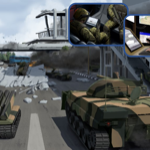Out to Sea
In the starlight, sailors move easily on the gently rolling deck of the ship, stepping confidently amongst looming black van-sized rectangular shapes festooned with fabric. The soundtrack is a combination of an erratic swishing as the swell surges along the hull and the hum of a generator somewhere deep beneath their feet. This is overlaid by the click and clack of tools releasing fastenings and an occasional soft curse as a strap snapping free slaps a limb. A Leading Seaman drags a heavy rubber twin hose to one side of the first of the van-sized shapes. In the darkness she uses touch to mate the hose’s nozzle with an aperture on the side of the van-sized object. “Nozzle sealed”, she calls softly – “foam on”. There is a gurgle as fluids begin to flow, followed almost immediately by a surging bubbling noise as chemicals react at the nozzle. For a moment, escaping vapour hisses before the foam seals a microscopic gap. A chemical smell wafts – a harsher acetic version of that familiar plastic ‘new-car smell’. As foam surges out of the nozzle and billows into the fabric envelope it booms like a garden hose rinsing leaves from a trampoline.
Like some strange transformer toy, the dark van-sized shape grows. First, the fabric hanging on all four sides begins to swell with a strange low-hanging pregnancy – then it takes animal form – growing a head, hanging gills and a dragon-like tail. It becomes some crouching beast with a barrel on its back. The Leading Seaman calls “rotate the struts”, and two of her sailors grab the streamlined bars connected to the flabby side envelopes and swing them forwards and outwards till both lock with a sharp crack, angled up at 45°. The monster has grown hanging pulsing arms like some wobbly Minotaur.
As foam surges through sectioned fabric compartments, the swishing metamorphosis continues, though more bat than butterfly. The sagging sack at the front becomes a graceful fishlike nose, the drooping arms rise and form arched wings that curve from where they emerge at the top of the body reaching down to just above the ship’s deck. The sagging reptilian tail suddenly pops up like a performing seal’s tail. Sailors move around the inflated transformer-like creature, which is actually a surface effect craft, affectionately known as a WIG, for ‘wing-in-ground’ effect. The sailors slap the pressurised fabric, testing for the drum like sound of a gas-filled void that might weaken the craft’s structural integrity. The sound of material filling the craft changes. The gurgles slow and stop. The pumps begin to whine as they struggle to deliver higher pressure – then there is a crack as the relief valve operates, spraying strips of pungent foam.
The Leading Seaman now steps forward. As she grabs a strop that is hanging over the port wing with one hand and she signals into the darkness with the other hand raised. Another sailor connects the WIG to a line that leads over the side of the ship to something floating unseen in the gloom below. 16
There is a whir above as the crane operator, with the benefit of night goggles, deftly delivers the hook to the Leading Seaman’s reaching hand. The strop is snapped into the hook and released. “Pop the shackles” is ordered, and a sailor moves around beneath the wings of the poised bird, using a mallet to strike the four release levers in turn. With each blow the craft bobs as the swollen pressurised belly exerts itself on the deck. “Clear for lifting”, the Leading Seaman calls, and the strange water bird is gently hoisted, swung well clear of the ship and slowly lowered into the surging sea.
Less than 20 minutes later a first wave of eight surface effect craft sit connected on a trailing line behind the slowly windward moving ship. Like a flock of ducklings following a rowboat, they bob with the ocean’s swells. On the bridge, the Captain looks to the Principal Warfare Officer for a confirming nod, then lifts the microphone to his face: “RASO, start engines in sequence”. In the control cabin the robotics officer begins the start-up sequence. The surface effect craft closest to the stern of the ship begins to emit a whine as a turbine spins up. This is quickly followed by a popping noise as paraffin ignites with a red glowing roar. The line from its nose to the ship slackens a little as the thrust takes effect. The second craft whines and growls into life, then the third and on down the line. At each ignition the Captain calls for an increase in ship’s speed. “Confirm status RASO” he calls, and the reply is: “Eight craft at 40% power ready for launch”. The captain orders: “launch speed”, and the entire ship shudders as its turbines spin up the propellers. Foaming cavities appear at the stern, in a monstrous imitation of a speedboat pulling water skiers.
All but the last in the accelerating towed line of craft remain firmly down in the phosphorescent glow of the ship’s wake – but the hindmost craft begins to bob on the water. As the procession reaches critical speed, the trailing vehicle pops up two metres above the swell crest. It is suspended, pitching very gently, as the cushion of air beneath its wings interacts with the water surface, the wing in ground effect that accentuates lift and provides a name for the six tonne Wiglander6000s.  The ship accelerates again, and the extra speed lifts the trailing craft above the surface. As the first rises further, the next craft leaps from the water, hesitates at the two-metre point, and then follows the first higher. Within 30 seconds the invisible towing cable is curling up into the sky suspending eight batlike shadows behind the ship. They ride smoothly on the clean air behind and above the ship ahead.
The ship accelerates again, and the extra speed lifts the trailing craft above the surface. As the first rises further, the next craft leaps from the water, hesitates at the two-metre point, and then follows the first higher. Within 30 seconds the invisible towing cable is curling up into the sky suspending eight batlike shadows behind the ship. They ride smoothly on the clean air behind and above the ship ahead.
There is a simultaneous flash beneath all the shadows as explosive shackles shear and the segmented cable drops clear. Freed from the drag, the ship surges for a moment. The Wiglander craft peel left and right, and descend back into ground effect, the higher ones diving slightly to maintain speed. In the darkness, the watchers on the ship barely see the dark shapes until they whine past and the glow of the turbojet disappears into the darkness of the horizon. The ship heels over as it turns hard to go back on its track, ready to launch another wave.
Successive waves of Wiglander6000s skim across the sea, with minimal signature as they fly so close to the Earth’s surface there is little metal aboard other than the jet engine – and the alloys of the light armoured vehicle in the cargo belly of each. They race towards the island at over a hundred knots towards the island. Several kilometres ahead and no more than 20m above them flies a sleek plastic fixed wing drone, catapult launched from the mother ship. Its passive sensors stare out across the sea to detect craft ahead, ready to command the swarm behind to take evasive action. It is a vital scout for a flock of machines that cannot suddenly change direction because sharp banking risks wingtips striking the water with catastrophic effect.
‘Heat. Faint heat.
The infrared eye sees first, but now the algorithm will make its visual range twin will look harder. Multiple service objects. Spread wide. Compute course adjustment. Command course adjustment.’ Within two seconds of the scout drone sensing something ahead the waves of Wiglander behind gently begin to correct their course. Ten minutes later, they overtake a flotilla of surface platforms bound on a similar heading. These long, sleek high-speed landing craft appear to be emulating their smaller faster cousins and trying to take off despite their two-hundred-ton loads. It is an apt illusion, for the hybrid diesel powered catamarans are now flying in water, for at full speed the twin hulls rise clear of the wave tops as they ride on the retractable hydrofoil blades. These machines have, like their ancestors of the 1940s, offer transformation of littoral warfare, each capable of bringing two main battle tanks or three personnel carriers at speeds matching naval destroyers.
_______________________________________________________________________________________
Dr Charles Knight developed this narrative as part of concept development and design activity with EOS Defence Systems to inform current and future Australian autonomous and remote operations technology development. Many of the concepts covered in this narrative are being actively pursued by EOS Defence and numerous other Australian industry players.
Images by James Wilson-Knight

Dr Charles Knight
Dr Charles Knight explores how to reduce the risks and costs of combat amongst structures and populations – an interest sparked when as a Parachute Regiment officer he was tasked to develop urban combat and subterranean capabilities for confronting the Soviets in the German city of Hildesheim. He is a senior researcher at the University of NSW, Canberra and an adjunct lecturer at Charles Sturt University. HisMasters research analysed vulnerabilities to asymmetric attacks in citiesandhis PhDexamined coercion duringcounterinsurgency– both informed by field research in the Lebanon and Cambodia, as well as by uniformedservice with the RAF, British and Omani Armies and in Asia. In Australia he served in 1 Commando Regiment, commanded 2/17 Bn, Royal New South Wales Regiment, spent a decade in the Special Operations development branch, drove reform of close combat training and wrote the Australian Army urban doctrine.



